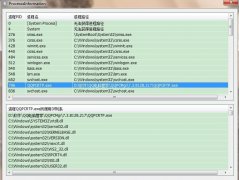C语言库函数 (E类字母)
[ 发表日期:2002-1-4 9:28:46
]
函数名: ecvt
功 能: 把一个浮点数转换为字符串
用 法: char ecvt(double value,
int ndigit, int *decpt,
int *sign);
程序例:
#include
#include
#include
int main(void)
{
char *string;
double value;
int dec, sign;
int ndig = 10;
clrscr();
value = 9.876;
string = ecvt(value, ndig,
&dec, &sign);
printf("string = %s
dec = %d
sign = %d
", string,
dec, sign);
value = -123.45;
ndig= 15;
string = ecvt(value,ndig,&dec,&sign);
printf("string = %s
dec = %d sign = %d
",
string, dec, sign);
value = 0.6789e5; /* scientific
notation */
ndig = 5;
string = ecvt(value,ndig,&dec,&sign);
printf("string = %s
dec = %d
sign = %d
", string,
dec, sign);
return 0;
}
函数名: ellipse
功 能: 画一椭圆
用 法: void far ellipse(int
x, int y, int stangle, int
endangle,
int xradius, int yradius);
程序例:
#include
#include
#include
#include
int main(void)
{
/* request auto detection
*/
int gdriver = DETECT, gmode,
errorcode;
int midx, midy;
int stangle = 0, endangle
= 360;
int xradius = 100, yradius
= 50;
/* initialize graphics,
local variables */
initgraph(&gdriver,
&gmode, "");
/* read result of initialization
*/
errorcode = graphresult();
if (errorcode != grOk)
/* an error occurred */
{
printf("Graphics error:
%s
",
grapherrormsg(errorcode));
printf("Press any key
to halt:");
getch();
exit(1);
/* terminate with an error
code */
}
midx = getmaxx() / 2;
midy = getmaxy() / 2;
setcolor(getmaxcolor());
/* draw ellipse */
ellipse(midx, midy, stangle,
endangle,
xradius, yradius);
/* clean up */
getch();
closegraph();
return 0;
}
函数名: enable
功 能: 开放硬件中断
用 法: void enable(void);
程序例:
/* ** NOTE:
This is an interrupt service
routine. You can NOT compile
this program
with Test Stack Overflow
turned on and get an executable
file which will
operate correctly.
*/
#include
#include
#include
/* The clock tick interrupt
*/
#define INTR 0X1C
void interrupt ( *oldhandler)(void);
int count=0;
void interrupt handler(void)
{
/*
disable interrupts during
the handling of the interrupt
*/
disable();
/* increase the global counter
*/
count++;
/*
re enable interrupts at
the end of the handler
*/
enable();
/* call the old routine
*/
oldhandler();
}
int main(void)
{
/* save the old interrupt
vector */
oldhandler = getvect(INTR);
/* install the new interrupt
handler */
setvect(INTR, handler);
/* loop until the counter
exceeds 20 */
while (count < 20)
printf("count is %d
",count);
/* reset the old interrupt
handler */
setvect(INTR, oldhandler);
return 0;
}
函数名: eof
功 能: 检测文件结束
用 法: int eof(int *handle);
程序例:
#include
#include
#include
#include
#include
int main(void)
{
int handle;
char msg[] = "This
is a test";
char ch;
/* create a file */
handle = open("DUMMY.FIL",
O_CREAT O_RDWR,
S_IREAD S_IWRITE);
/* write some data to the
file */
write(handle, msg, strlen(msg));
/* seek to the beginning
of the file */
lseek(handle, 0L, SEEK_SET);
/*
reads chars from the file
until hit EOF
*/
do
{
read(handle, &ch, 1);
printf("%c", ch);
} while (!eof(handle));
close(handle);
return 0;
}
函数名: exec...
功 能: 装入并运行其它程序的函数
用 法: int execl(char *pathname,
char *arg0, arg1, ..., argn,
NULL);
int execle(char *pathname,
char *arg0, arg1, ..., argn,
NULL,
char *envp[]);
int execlp(char *pathname,
char *arg0, arg1, .., NULL);
int execple(char *pathname,
char *arg0, arg1, ..., NULL,
char *envp[]);
int execv(char *pathname,
char *argv[]);
int execve(char *pathname,
char *argv[], char *envp[]);
int execvp(char *pathname,
char *argv[]);
int execvpe(char *pathname,
char *argv[], char *envp[]);
程序例:
/* execv example */
#include
#include
#include
void main(int argc, char
*argv[])
{
int i;
printf("Command line
arguments:
");
for (i=0; i printf("[%2d] : %s ", i, argv[i]); printf("About to exec child with arg1 arg2 ... "); execv("CHILD.EXE", argv); perror("exec error"); exit(1); } 函数名: exit 功 能: 终止程序 用 法: void exit(int status); 程序例: #include #include #include int main(void) { int status; printf("Enter either 1 or 2 "); status = getch(); /* Sets DOS errorlevel */ exit(status - '0'); /* Note: this line is never reached */ return 0; } 函数名: eXP 功 能: 指数函数 用 法: double exp(double x); 程序例: #include #include int main(void) { double result; double x = 4.0; result = exp(x); printf("'e' raised to the power of %lf (e ^ %lf) = %lf ", x, x, result); return 0; }
- 上一篇:C语言库函数 (D类字母)
- 下一篇:lzw压缩算法的c语言实现





